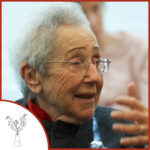

Birth: July 12, 1913
Specialty: Physical Biochemistry
Major Contributions:
A pioneer in use of nuclear magnetic resonance for studying enzyme reactions
Awarded National Medal of Science
First woman to receive American Heart Association’s Lifetime Career Award
Authored 160 papers
Image: Science History Institute (CC BY-SA 3.0)
Inducted into the Women’s Hall of Fame in 2009, Dr. Mildred Cohn faced discrimination not only as a woman but also a Jewish woman. Told by one of her college professors that studying chemistry was unladylike, she nonetheless earned a degree in the subject in 1931.
The economics of the Great Depression had forced the closing of her father’s business and after earning a master’s degree from Columbia the next year, she was out of money. Looking for work, she took the civil service exam and was hired by the National Advisory Committee for Aeronautics. Given a position lower than the one she qualified for, she was banned from actual lab work because she was a woman. Frustrated by this limitation she devised a plan: she would design the experiments, a male coworker would do the actual lab work and she would analyze the results – which surprisingly her supervisor agreed to.
After being told that she would never get a promotion, again due to gender, she left NACA and returned to Columbia. Graduating with a doctorate in physical chemistry in 1938 she started hunting for employment. This proved difficult because many of the ads for work stated they were only looking for male Christian applicants. She persevered and eventually she was hired as a researcher, where she pioneered the use of isotopic tracers to examine the metabolism of sulfur-containing compounds.
Cohn spent twenty years as a researcher in university lab settings, making great strides in the use of isotopic oxygen-18, nuclear magnetic resonance, and electron paramagnetic resonance to investigate enzyme metabolism. Using these methods, she was able to make many discoveries about the structure and enzymatic reactions of Adenosine-5′-triphosphate, known as ATP. This molecule can be used for energy transfer in a cell and is also found in the process of DNA replication and transcription.
Becoming a full professor in 1959 at the University of Pennsylvania she became the first woman to receive the American Heart Association’s Lifetime Career Award five years later. She retired in 1982, the same year she was recognized with the highest science award in the U.S., the National Medal of Science.
Written by Angela Goad
Sources:
Science History Institue Museum & Library: Mildred Cohn
Jewish Women’s Archive: Mildred Cohn
National Women’s Hall of Fame: Mildred CohnWikipedia: Mildred Cohn
See Also:
Women in Medicine at Washington University of Medicine: Mildred Cohn
Nuclear Magnetic Resonance Spectroscopy
Women in Chemistry: Mildred Cohn
